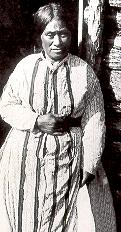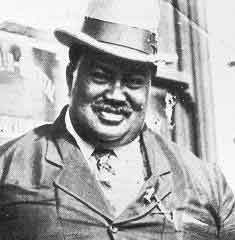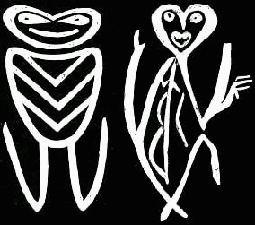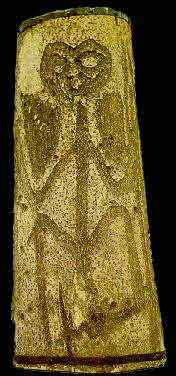The conquering Maori had their own immediate conflicts however.
Not content with life on the Chathams, the chief of the Ngati Tama, Meremere, devised a plan to invade Samoa, and he arranged for his warriors to be collected from the beach at Waitangi. The Ngati Mutunga also devised a plan to invade Norfolk Island.
A French whaling vessel, "Jean Bart", arrived at Waitangi, and some of the Maori assembled there came aboard. Matioro wanted the ship to move to Whangaroa to collect his warriors - Meremere wanted it to stay where it was.
Fighting erupted between the assembled Maori and the French were immediately drawn into the battle. The French crew were killed and the ship burnt.
In 1838 the French corvette "Heroine", assisted by the the whalers "Adele" and the "Rebecca Sims" arrived from New Zealand, and Ngati Tama were enjoined to come aboard - and siezed. The gunship then obliterated their settlement at Waitangi and moved on to sack three more settlements at Ouira, Ocean Bay and Whangaroa, as well as destroying seven large waka, irreplaceable canoes.
The women captives were later released, but three Maori, including the chief Ngatuna, were taken back to France - he later committed suicide.
The Ngati Mutunga exploited this depletion of the Ngati Tama to 180 people, by building pa near by, and hostilities were not ended until the NZ Company brokered a peace, and bought the land
Ernst Dieffenbach, of the NZ Company, was horrified by the degradation of the Moriori, now slaves.
".. the misery which they suffer from the oppressive sway of the New Zealanders, and from want of sufficient nourishment ..they are the labourers and porters of their masters, who have no notion of anything like moderation in the labour they exact ; so that ulcerated backs bent almost double, and emaciated paralytic limbs, with diseased lungs, are the ordinary lot .. to whom death must be a blessing"
Koche, a strong Moriori had escaped to sea aboard a whaling ship, and he told his story to a lawyer, Ewing, who recorded all in a journal around 1850.
Koche had been captured and taken to Matioro's house, where he was put to work fishing. he landed a poisonous fish, which he sneaked into a normal catch and delivered to the Matioro's cook before fleeing - she fed some to a dog which immediately died, and Matioro scoured the island for Koche. Eventually Matioro believed that Koch had committed suicide rather than face his wrath.
Koche was hiding on Pitt Island, where he lived a solitary existence for some years, before being caught again by Matioro. Again he escaped, and found refuge on an American whaler. His eventual fate is unknown
Matioro, in 1842, decided to colonise the Auckland Islands, 500 km to the southwest that he had seen from a whaler. He took with him forty Maori, and thirty Moriori slaves to the sub-Antartic island group, where at least two slaves would be murdered, and others die of illness.
Matioro was probably bored, and possibly a little worried. The invasion of Samoa hadn't come off, Christian missionaries had arrived on the Chathams, local warfare was nonexistent - and the French were possibly going to come back and extract more revenge for the destruction of the "Jean Bart".
He chartered the ship "Hannah" for the journey, that had arrived from NZ, which had itself been hijacked by a man named Ellis - who was later arrested, tried and sentenced to life imprisonment on Norfolk Island.
Matioro didn't know that the Islands were not even remotely hospitable, being wind-, sleet-, and snow-swept, and that the soil was peat, incapable of growing the food they planned.
The ship arrived in late 1842, at Port Ross, and the takahi party returned soon with the shocking news - the Islands were desolate. Immediately, the chiefs Tangari Te Uma and Motu-karaka ordered that the ship sail back to the Chathams.
Matiori was essentially shipwrecked with his companions, his slaves (including Rohana, below), their considereable stores, and cannon from the "Jean Bart", and they lived on the Island for the next 14 years.
He built his first pa on Crozier Point, and the colonizers settled into a hard life. Once the stores ran out, they subsisted on potatoes the size of marbles, turnips abnd seal meat.
The Moriori would probably have adapted more easily to the seal diet, and harsh enviornment than would the Maori, but of this time we know very little.
In 1849, the "Samuel Enderby" sailed into Port Ross, and Charles Enderby, who was aboard, had arrived as the head of a group of English colonists who planned a whaling station. They were to be as rudely shocked by conditions as had Matiori.
Enderby proclaimed,
"I am the Lord of the Island. I claim all the land which you are using
and all the pigs you possess"
and that was that - Matiori and Ngatere were deputised as constables, and
the Moriori continued as slaves.
Despite a visit by Governer Grey in 1850, and the outlawing of slavery in New Zealand ten years earlier.
In 1852 the whaling base was abandoned as a waste of money, and the Europeans left, followed finally by Matiori two years later, with nineteen Maori and twelve Moriori, leaving the chiefs Tapae and Tupara behind. They all went to Stewart Island.
On the Chathams, Tangari Te Uma and Petere Roiri chartered the ship "Lalla Rookh" and made the journey first to Stewart Island to collect Matiori and then on to the Auckland Islands, where they collected the last survivors, arriving at the Chathams in 1856.
Some Moriori remained on Stewart Island, and their descendants moved to the South Island of NZ.
Matioro, back on the Chathams, was now no longer "Chief of all the New Zealanders" as he had been on the Auckland Islands, but he was bellicose as ever.
 |
He is recorded in 1859 by the resident Magistrate, Shand, as having "pursued and forcibly taken back" his slave Rohana, one the Auckland Is. survivors, after she had absconded to marry Hirawanu Tapu. The constable at Waitangi "could not, or would not venture to interfere" when Rotana was taken back into slavery. |
In 1862, some twentyseven years later, Sir George Grey received a letter from Tapu Te Ara asking for help.
"Friend, let no other peoples of the world ask why this people did not hold on to their lands. It was because we were a people who did not know anger or how to fight. The custom of this land was that when one bled and another bled, that was it. We were a people who dwelt in peace, who did not believe in killing and eating their own kind. Our word for that kind of person is kaupeke: a flesh-eating demon. The manner of this people was like a flock of lost sheep .. when the shepherd went away, the wild dog came to eat them .. Friend, we must have the rights to our own lands, because we are the rightful owners of our ancestors' home - of that land planted here by God at the time our forefathers arrived in this place .."
Grey did nothing, despite the presence on the Island of a Magistrate since 1855. It was not until 1863 that a general manumission was declared.
The NZ Government decided in 1866 to use the Chathams as a perfect place to send it's own Maori prisoners from the Land Wars, in short, to make it a penal colony, and the first "hauhau" prisoners arrived, 43 men and 25 wives and children.
Most Maori however had left the Island, and were back in New Zealand, by 1870.
They returned immediately for a Native Land Court sitting to examine Moriori claims for their land back. The Moriori did not succeed - despite clear evidence of the invasion and seizure by arms, the Court basically ruled that the invasion and current occupation nullified previous land titles.
In other words, the New Zealand Native Land Court ruled that because the land had been seized by force of arms, and had then been continually cultivated by the invaders - then from henceforth, they owned it. Maori were awarded title to 97.7% of the Chatham Islands lands.
It was a real politik solution for the NZ Government - Maori had to be present at the Land Court, which meant they couldn't be stirring up trouble in New Zealand. The granting of title to land acquired by killing the owners was a matter of decree.
Slavery was not outlawed in the Chathams until 1863.
At the time of Tapu Te Ara's plea to Governor Grey, the Moriori population was down to 101, and by 1900, there were only a handful of Moriori alive, and the last full-blooded Moriori, Tame Horomana Rehe Solomon, (below) or Tommy Solomon, died at the age of 48 in 1933.

Some of Tommy Solomon's descendants live in New Zealand, and some still on the Chathams, like the Preece family.
Several studies of Moriori culture and history have been published by the Polynesian Society of New Zealand.
One paper, "The Moriori People of the Chatham Islands - their history and traditions" vol II, dated 1911, was by Alexander Shand, a collection of tales,and legends, with some chants and songs, written in the original language and partly translated into English.
Two later studies, one published in 1923, were by the Bavard Dominick expedition, of Honolulu,"The Moriori of the Chatham Islands, Berne P Bishop, vol XI, no 1" and by H D Skinner and William Bauke "The Moriori of the Chatham Islands, Berne P Bishop, vol XI, no 5" .
The Honolulu paper has two photographs of Moriori bone flutes, one with finger holes.

The Moriori are remembered for their solemn, simplistic but eerily evocative - almost other-worldly images - the tree carvings ("dendroglyphs") left on the Island.

In June 2001, the NZ Govt's Waitangi Tribunal recommended that the Moriori people be compensated for slavery, loss of land and hardship, and that it was 'patently wrong' to grant 97 percent of the land to Ngati Mutunga.
This
Web Directory will always be dynamic ~
all details are flexible and changing